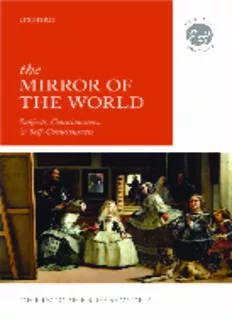
The Mirror of the World: Subjects, Consciousness, and Self-Consciousness PDF
Preview The Mirror of the World: Subjects, Consciousness, and Self-Consciousness
The Mirror of the World Subjects, Consciousness, and Self-Consciousness Christopher Peacocke 1 3 GreatClarendonStreet,Oxford,OX26DP, UnitedKingdom OxfordUniversityPressisadepartmentoftheUniversityofOxford. ItfurtherstheUniversity’sobjectiveofexcellenceinresearch,scholarship, andeducationbypublishingworldwide.Oxfordisaregisteredtrademarkof OxfordUniversityPressintheUKandincertainothercountries ©ChristopherPeacocke2014 Themoralrightsoftheauthorhavebeenasserted FirstEditionpublishedin2014 Impression:1 Allrightsreserved.Nopartofthispublicationmaybereproduced,storedin aretrievalsystem,ortransmitted,inanyformorbyanymeans,withoutthe priorpermissioninwritingofOxfordUniversityPress,orasexpresslypermitted bylaw,bylicenceorundertermsagreedwiththeappropriatereprographics rightsorganization.Enquiriesconcerningreproductionoutsidethescopeofthe aboveshouldbesenttotheRightsDepartment,OxfordUniversityPress,atthe addressabove Youmustnotcirculatethisworkinanyotherform andyoumustimposethissameconditiononanyacquirer PublishedintheUnitedStatesofAmericabyOxfordUniversityPress 198MadisonAvenue,NewYork,NY10016,UnitedStatesofAmerica BritishLibraryCataloguinginPublicationData Dataavailable ISBN978–0–19–969956–8 Asprintedandboundby CPIGroup(UK)Ltd,Croydon,CR04YY LinkstothirdpartywebsitesareprovidedbyOxfordingoodfaithand forinformationonly.Oxforddisclaimsanyresponsibilityforthematerials containedinanythirdpartywebsitereferencedinthiswork. The Mirror of the World Context and Content Series editor: François Recanati, Institut Nicod Othertitlesintheseries: TheInessentialIndexical OnthePhilosophicalInsignificanceofPerspectiveandtheFirstPerson HermanCappelenandJoshDever AssessmentSensitivity RelativeTruthanditsApplications JohnMacFarlane Contents AcknowledgementsandSources ix I Introduction 1 II PrimitiveSelf-Representation 6 1. TheBasicNotion 6 2. Self-Files 14 3. ThreeDegreesofSelf-Representation 30 III TheMetaphysicsofConsciousSubjects 40 1. ConsciousnessandConsciousSubjects:An Interdependence 40 2. AResponsetoHume 44 3. TheConsequencesofInterdependence 57 4. ContemporaryDifferences:AHistoricalAffinity 68 IV TheFirstPersonConceptanditsNonconceptualParent 80 1. SomeBackgroundonConcepts 81 2. ExplainingFourPhenomena 86 3. IssuesofAcquaintance 99 V ExplainingFirstPersonPhenomena 106 1. ExplainingImmunitytoErrorthroughMisidentification 106 2. CanWeDispensewithFirstPersonNotions andConcepts? 113 VI DescartesDefended 127 1. TheSoundnessoftheCogito 128 2. WhatCanthePerspectiveofConsciousnessSupply? 139 3. Entitlement,theSecondCogito,andAnscombe 146 VII ParalogismsandFirstPersonIllusions 154 1. TheIssues 154 2. SomeRepliestoKant’sObjections 159 3. Strawson’sNeo-KantianConceptionofSubjects 178 viii CONTENTS VIII PerspectivalSelf-Consciousness 188 1. WhatistheSignificanceoftheMirrorTest? 190 2. AWiderCriterionforPerspectivalSelf-Consciousness 194 3. TheReorientationAccountandOtherMinds 203 IX ReflectiveSelf-Consciousness 213 1. CharacterizingReflectiveSelf-Consciousness 213 2. MetaphysicsandEpistemologyofReflective Self-Consciousness 217 3. FirstPersonTheoriesofUnderstanding,andEmpirical Phenomena 223 4. ReflectiveandPerspectivalSelf-Consciousness: TheirSignificanceforInquiry 232 5. ReflectiveSelf-ConsciousnessandtheConceptionof ManyMinds 234 X InterpersonalSelf-Consciousness 236 1. IllustrationandDelineation 237 2. SomeRolesofInterpersonalSelf-Consciousness 243 3. IsThereanIrreducibleSecondPersonConcept? 247 4. PhilosophicalandPsychologicalIssues 250 5. Self-Consciousness:TheRelationsoftheInterpersonalto OtherVarieties 260 6. ConcludingRemarks 263 AppendixA 264 AppendixB 266 XI OpenConclusion:ThePlaceofMetaphysics 267 References 269 Index 277 Preface ThisbookcontainsarevisedversionofthetextfromwhichIdrewtwo setsoflectures,bothgivenunderthetitle‘Subjects,Consciousness,and Self-Consciousness’.Thefirstsetwasgivenintheautumnof2010inthe ‘ContextandContent’seriesdirectedbyFrançoisRecanatiattheInstitut JeanNicod,intheÉcoleNormaleSupérieureinParis.Thesecondsetwas given a few months later in the Winter Quarter of 2011 as the Kohut LecturesattheCommitteeonSocialThoughtattheUniversityofChicago. IwarmlythankFrançoisRecanati,JonathanLear,RobertPippin,andthe CommitteeonSocialThoughtfortheseinvitations,andthanktooallthose involvedinthestimulatingexchangesthatfollowedeachoftheselectures inParisandChicago.Thepresenttextresultsfromrevisionsmadeinthe lightofthosediscussions,andofdiscussionsatmyseminarsatColumbia UniversityandUniversityCollegeLondon. IntherevisedtextIhavetriedtopreservethedirectandconcisestyle appropriate for a lecture. This is not a comprehensive critical survey of theliteraturetoacertaindate.Nordoesthematerialtouchuponallthe topics with which issues about the self and self-consciousness have important internal connections. Rather, the material develops, cumula- tively, a few basic ideas about subjects and the first person, and applies them to some classical and to some recent issues in the philosophy of mind,epistemology,metaphysics,andthetheoryofintentionalcontent. InthetitleofthisbookIborrowtheimageofthesubjectofconscious- nessasthemirroroftheworldfromSchopenhauer,whoemployeditin connection with what he called the pure subject of cognition. Though pleasing inseveral respects, theimagecan alsomislead.Mirrors donot usuallyreflectthemselves,whereasthesubjectispartoftheworldtobe reflected.Iftheselecturesarecorrect,subjectsdopartially reflectthem- selves. Perhaps it is good to keep in mind an image that in its nature remindsusoftheever-presentdangersofparadox,ungroundedness,and impossibilityinthisperenniallyfascinatingtopic. Thechoiceofcoverillustrationforthisbookposedaproblem.While thereiscertainlynodearthofattemptstodepicttheselfinWesternart, Iwaslookingforsomethingthatwouldalsoillustratethevarietiesofself-
Description: